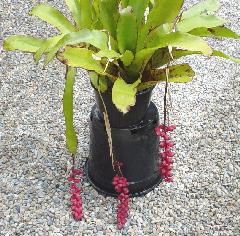
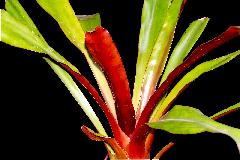
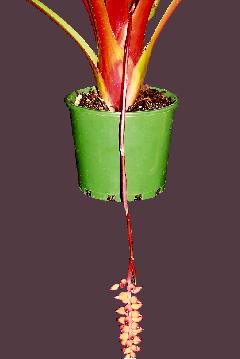
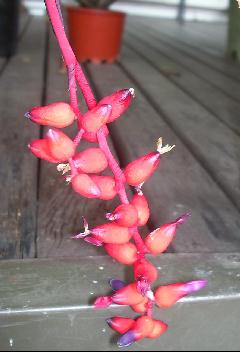
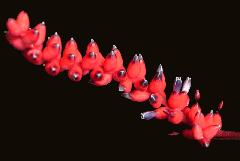
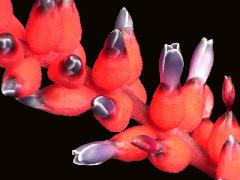
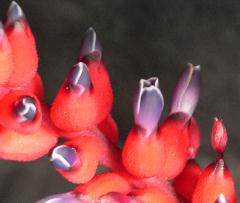
This new species is related to A. fulgens Brongn. and to A. capixaba L. B. Smith. It differs from both by its much longer and pendulous inflorescense and other details. From A. racinae L. B. Smith, with pendulous inflorescense also, our new species differs in the composite inflorescence, sessil flowers and other details evident in the description.
Dedicamos esta especie ao Sr. Eddie Waras, cultivador de plantas e que muito tem colaborado nos enviando plantas especialmente Orchidaceae e Bromeliaceae.
Desc from S&D
Plant stoloniferous, flowering 7-9 dm high with the inflorescence raised.
Leaves forming a funnelform rosette, 35-65 cm long;
Sheaths obovate, 6-8 cm wide, densely brown-lepidote within;
Blades ligulate, contracted toward base, rounded, apiculate, 4-5 cm wide, broadly channeled, sparsely and obscurely lepidote, sparsely and minutely serrulate.
Scape strongly decurved, 5 mm thick, verruculose, dark purple;
Scape-bracts 12-15 cm long, exceeding the internodes, linear-lanceolate, acuminate, entire, paleaceous, red becoming white outside and violet inside.
Inflorescence 20-25 cm long, bipinnate at base, simple toward apex with straight, verrucose rhachis and 20-35 polystichous flowers;
Primary bracts like the scape-bracts, exceeding the spikes;
Spikes geniculate, distichously (?) 2-5-flowered.
Floral bracts minute, triangular, apiculate, paleaceous;
Flowers spreading, sessile, 25-30 mm long.
Sepals free, asymmetric, subapiculate, 8-10 mm long, unarmed, dark violet with white margins;
Petals linear oblong, acute, 17 mm long, bearing 2 denticulate scales at base, the blades reflexed at anthesis, violet with white margins, turning deep red;
Stamens included, second series filaments half-adnate to petals; anthers dorsifixed; pollen globose, 4-porate;
Ovary globose; placentae apical; ovules few, long-caudate.
Type. Waras s n (holotype, HB; isotypes, RB, US), Domingos Martins, Espirito Santo, Brazil, flowered in cultivation 20 Aug 1971.
Distribution. Known from the type collection only.
Aechmea warasii var. discolor Pereira, Bradea 2: 308. 1979
Differt a forma typica foliis omnis discoloribus, ventraliter viridibus, dorsaliter nitide atropurpureis.
The leaves of this plant, all equally discolor, green on the upper face but dorsally shiny dark purple.
Habitat Espirito Santo, Morro da Televisao near Vitoria, 50msm., Legit Roberto A Kautsky n. 615 – 28 Nov. 1978. Holotype HB 67218
Aechmea warasii E. Pereira var. intermedia (E. Pereira) Pereira & Leme J. Brom. Soc. 35(2):66, 69. 1985
Basionym: Aechmea racinae L. B. Smith var. intermedia E. Pereira (Bradea, vol. III, no.7, p. 47, 1980.)
Differt a forma typica oblongo, breviter pedicellato, ovario roseo, et sepalis leviter albiazureis.
Differs from type by oblong, short pedicel, ovaries red, and sepals slightly pale blue
Type: Kautsky 460 (holotype, HB 69535), Domingos Martins, Espirito Santo, Nov. 20, 1979.
Notes from Herbarium Bradeanum, No.1: Aechmea warasii var. intermedia by Edmundo Pereira and Elton M. C. Leme in J. Brom. Soc. 35(2):66, 69. 1985
There are two interesting species of bromeliad found in the Brazilian State of Esprrito Santo: Aechmea warasii E. Pereira and A. racinae L. B. Smith. Two varieties of the latter, tubiformis E. Pereira and erecta L. B. Smith also grow in that region.
In November 1979, Roberto Anselmo Kautsky, a collector of orchids and bromeliads, discovered in the County of Domingos Martins, Espirito Santo, a bromeliad related to both. A. warasii and A. racinae but showing characteristics distinguishing it from both. Since these characteristics were of an intermediate nature, the collected specimen was described as A. racinae var. intermedia.
After the first plant was collected, other specimens of the new variety were brought in from the country and from these it was possible to make new observations which revealed aspects that had not been noted previously. With this evidence, we began to think that relating this plant to A. racinae was a mistake. The new variety shows, among other characteristics, an inflorescence occasionally branched at the base, and blue petals, both typical of A. warasii. We have concluded, therefore, that it is necessary to describe a new combination and add an emendation.
A. warasii var. intermedia can be differentiated from the typical A. warasii on the basis of certain elements such as an oblong, short pedicel, rosy ovary, as well as whitish-blue sepals. Until now little has been known about the geographic distribution and ecology of this new variety except that its flowering period takes place between the months of October and November while the typical form blossoms between August and September. The var. intermedia can be cultivated successfully under humid and diffusely illuminated environments.